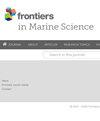揭示古吉拉特邦 Saurashtra 海岸 Shivrajpur 常见潮间带居民 Petrolisthes boscii(Audouin,1826 年)的种群结构和繁殖模式
IF 3
2区 生物学
Q1 MARINE & FRESHWATER BIOLOGY
引用次数: 0
摘要
本研究的重点是调查猪笼草蟹(Petrolisthes boscii,Audouin,1826 年)的种群结构和繁殖生物学。考虑到该物种在生态功能(包括营养循环)中的关键作用及其对环境压力的潜在脆弱性,对其种群生态学进行评估至关重要。在连续 12 个月(2019 年 3 月至 2020 年 2 月)的退潮期间,在面积为 500 平方米的区域内采集了样本,并在退潮时采用了单位渔获量(CPUE)方法。采集到的标本(859 个)分为雄性(407 个)、非卵生雌性(452 个)和卵生雌性(303 个)。通过测量卵的特征,包括卵的总数、大小和重量,以及有卵雌体的胴体宽度,对繁殖力进行评估。雄性(8.60 ± 2.76)明显大于雌性(8.39 ± 2.46)(p &pamp;lt;0.001)。总性别比和月性别比均偏向于雌性(1:1.17)。此外,雄性个体和雌性个体的体型频率分布呈双峰分布。所有月份都有发情的雌性个体,这表明该物种全年都在繁殖,繁殖高峰期在 3 月至 5 月和 8 月至 10 月。观察发现,发情雌鸟的体型与其产卵总数(130.39 ± 83.31)、卵重(150 ± 110 mg)之间存在明显的正相关关系。这项研究可为今后研究不断变化的环境的影响和沿海地区日益增加的人为压力的后果提供基础信息。本文章由计算机程序翻译,如有差异,请以英文原文为准。
Unveiling the population structure and breeding patterns of Petrolisthes boscii (Audouin, 1826) a common intertidal inhabitant of Shivrajpur, Saurashtra Coast, Gujarat
The present study focused on investigating the population structure and breeding biology of a species of Porcellanid crab, Petrolisthes boscii (Audouin, 1826). Evaluating the population ecology of the species is essential considering its crucial role in ecological functions including the nutrition cycle and its potential vulnerability to environmental stressors. The samples were collected over a period of 12 consecutive months (from March 2019 to February 2020) in an area of 500 m2 during low tide, utilizing the catch-per-unit-effort (CPUE) method when the water receded. The collected specimens (859 individuals) were categorized into males (407 individuals), non-ovigerous females (452 individuals), and ovigerous females (303 individuals). The assessment of fecundity was conducted by measuring the egg characteristics, including the total number, size, and weight of the eggs, as well as the carapace width of the ovigerous females. There was an evident difference in size, with males (8.60 ± 2.76) being significantly larger compared to females (8.39 ± 2.46) (p < 0.001). The overall and monthly sex ratios were female-biased (1:1.17). Moreover, the size frequency distribution revealed a bimodal distribution in male as well as female individuals. Ovigerous females occurred in all the months, which shows that the species breeds continuously throughout the year, with peaks in the months of March to May and August to October. There was a significant positive relationship observed among the size of ovigerous females and their total number of eggs (130.39 ± 83.31), egg mass weight (150 ± 110 mg). The study may provide baseline information for future studies on the impacts of a continuously altering environment and the consequences of increasing anthropogenic pressure on coastal areas.
求助全文
通过发布文献求助,成功后即可免费获取论文全文。
去求助
来源期刊

Frontiers in Marine Science
Agricultural and Biological Sciences-Aquatic Science
CiteScore
5.10
自引率
16.20%
发文量
2443
审稿时长
14 weeks
期刊介绍:
Frontiers in Marine Science publishes rigorously peer-reviewed research that advances our understanding of all aspects of the environment, biology, ecosystem functioning and human interactions with the oceans. Field Chief Editor Carlos M. Duarte at King Abdullah University of Science and Technology Thuwal is supported by an outstanding Editorial Board of international researchers. This multidisciplinary open-access journal is at the forefront of disseminating and communicating scientific knowledge and impactful discoveries to researchers, academics, policy makers and the public worldwide.
With the human population predicted to reach 9 billion people by 2050, it is clear that traditional land resources will not suffice to meet the demand for food or energy, required to support high-quality livelihoods. As a result, the oceans are emerging as a source of untapped assets, with new innovative industries, such as aquaculture, marine biotechnology, marine energy and deep-sea mining growing rapidly under a new era characterized by rapid growth of a blue, ocean-based economy. The sustainability of the blue economy is closely dependent on our knowledge about how to mitigate the impacts of the multiple pressures on the ocean ecosystem associated with the increased scale and diversification of industry operations in the ocean and global human pressures on the environment. Therefore, Frontiers in Marine Science particularly welcomes the communication of research outcomes addressing ocean-based solutions for the emerging challenges, including improved forecasting and observational capacities, understanding biodiversity and ecosystem problems, locally and globally, effective management strategies to maintain ocean health, and an improved capacity to sustainably derive resources from the oceans.
 求助内容:
求助内容: 应助结果提醒方式:
应助结果提醒方式:


